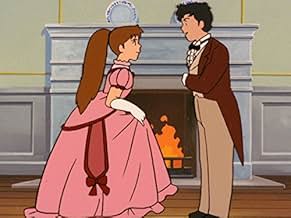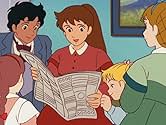IMDb-BEWERTUNG
7,5/10
916
IHRE BEWERTUNG
Louisa May Alcotts autobiografischer Bericht über ihr Leben mit ihren drei Schwestern. Die drei Schwestern leben bei ihrer Mutter. Die Geschichte erzählt, wie die Schwestern aufwachsen, Lieb... Alles lesenLouisa May Alcotts autobiografischer Bericht über ihr Leben mit ihren drei Schwestern. Die drei Schwestern leben bei ihrer Mutter. Die Geschichte erzählt, wie die Schwestern aufwachsen, Liebe finden und ihren Platz in der Welt finden.Louisa May Alcotts autobiografischer Bericht über ihr Leben mit ihren drei Schwestern. Die drei Schwestern leben bei ihrer Mutter. Die Geschichte erzählt, wie die Schwestern aufwachsen, Liebe finden und ihren Platz in der Welt finden.
Folgen durchsuchen
Handlung
WUSSTEST DU SCHON:
- WissenswertesLouisa May Alcott's autobiographical account of her life with her three sisters.
- VerbindungenFollowed by Missis Jo und ihre fröhliche Familie (1993)
- SoundtracksMujercitas
(Spain)
Written by Begoña Ramos
Composed by Vincenzo Draghi
Performed by Sol Pilas (uncredited)
Ausgewählte Rezension
Japanese animators have quite an affinity for "Little Women," the 1868 American novel by Louisa May Alcott that has been made into at least three Hollywood films and several American TV productions. There was a 68-minute animated TV special in Japan in 1980, followed by a 1981 animated series that ran for 26 episodes. This entry is for the second animated TV series, produced in 1987 as part of the long-running "World Masterpiece Theater," which adapted a large number of Western children's favorites into anime. For this review I watched a 92-minute VHS tape featuring two 46-minute episodes compiled from scenes from several episodes, and a 47-minute compilation of two Christmas-themed episodes released on VHS as "Little Women's Christmas Story." The first tape is in Japanese with no subtitles, while the second was dubbed into English. The "Christmas Story" tape is the only edition I know of from this series that got any distribution in the U.S.
The 1987 series (aka "Ai no Wakakusa Monogatari") is a lot more polished than the 1981 series (which I've also reviewed on IMDb). The colors are richer, the set design and background artwork smoother and the character design much more attractive. (The girls look a lot prettier here.) The lower budget of the first series meant a starkness about the design that created a greater sense of wartime hardship and lent a more melancholic feeling to the proceedings. The walls in the various homes were quite bare and empty space abounded, quite unlike actual homes in New England in that era. The newer series doesn't fill up the space quite as much as it should either, but there is wallpaper on the walls and quite a few more pictures and wall hangings. Overall, the images are much more beautiful in the newer series. (Which doesn't mean the first series doesn't have much greater emotional power at times.)
The compilation tape I watched offered vignettes of life for the four March girls (Jo, Meg, Beth and Amy) during a time when their father is serving with the Union Army during the Civil War (1861-1865) and their mother is busy with charity work and war-related volunteer service. There's a gentle pace to it and a smooth flow to the editing and storytelling. We see Beth's earnest piano playing and the gift of an upright piano from rich neighbor Mr. Laurence. We see Jo make a drastic move to raise money for the family. We see a conflict between Jo and Amy escalate to the point where Amy retaliates by doing something truly horrible to Jo. A letter with bad news arrives one winter and Beth winds up falling ill and the family rallies round to care for her. The tape ends with a very happy reunion, though. In the Christmas-themed tape, we see the four sisters practice their Christmas play, which Jo has written, and use the money Aunt March gave them for gifts to reward someone other than themselves.
According to Jonathan Clements & Helen McCarthy's Anime Encyclopedia (2001, Stone Bridge Press), the series actually opened with a Confederate attack on the Pennsylvania town where the Marches live, forcing them to flee to "Newcord," Massachusetts. This is quite a big change from the beginning of the book. Clements & McCarthy describe the series opening as "An introduction seemingly designed to educate the Japanese audience about the events of the Civil War " They also say that "The first incident from the novel proper does not arise until episode 18 of the anime, whereas the first line from the novel does not appear until episode 21 " The compilation tape offered no shots from the series beginning and opens instead with the family nicely settled in "Newcord." The incidents depicted in the tape all seem to match things that happen in the book.
It's somewhat bizarre to hear Japanese being spoken in such a quintessential American setting. In one sequence we even see President Lincoln deliver the Gettysburg Address—in Japanese! Yet the Japanese voice actors sound so right for their characters. (Far better, in fact, than the English dubbers heard on the "Christmas Story" tape.) We hear occasional English phrases sprinkled in with the Japanese dialogue, e.g. "grand piano" and "Christmas present," and mentions of "Washington," "Lincoln," and "Grant." The music track includes such famous pieces of Americana as "Swanee River" by Stephen Foster. The family maid, Hannah, is a black woman here, whereas she was white in the 1981 series and all live-action versions I've seen.
The series was directed by Fumio Kurokawa from a screenplay by Akira Miyazaki, both of whom had worked on "Animated Classics of Japanese Literature" (1986). The character designer was Yoshifumi Kondo, who went on to do animation direction and design for Hayao Miyazaki (no relation to Akira). Kondo directed the Studio Ghibli masterpiece, WHISPER OF THE HEART, in 1995, but died three years later at the age of 47, after having last worked on Miyazaki's PRINCESS MONONOKE. There are definite points of resemblance between the female characters in WHISPER and the March girls from LITTLE WOMEN.
The 1987 series (aka "Ai no Wakakusa Monogatari") is a lot more polished than the 1981 series (which I've also reviewed on IMDb). The colors are richer, the set design and background artwork smoother and the character design much more attractive. (The girls look a lot prettier here.) The lower budget of the first series meant a starkness about the design that created a greater sense of wartime hardship and lent a more melancholic feeling to the proceedings. The walls in the various homes were quite bare and empty space abounded, quite unlike actual homes in New England in that era. The newer series doesn't fill up the space quite as much as it should either, but there is wallpaper on the walls and quite a few more pictures and wall hangings. Overall, the images are much more beautiful in the newer series. (Which doesn't mean the first series doesn't have much greater emotional power at times.)
The compilation tape I watched offered vignettes of life for the four March girls (Jo, Meg, Beth and Amy) during a time when their father is serving with the Union Army during the Civil War (1861-1865) and their mother is busy with charity work and war-related volunteer service. There's a gentle pace to it and a smooth flow to the editing and storytelling. We see Beth's earnest piano playing and the gift of an upright piano from rich neighbor Mr. Laurence. We see Jo make a drastic move to raise money for the family. We see a conflict between Jo and Amy escalate to the point where Amy retaliates by doing something truly horrible to Jo. A letter with bad news arrives one winter and Beth winds up falling ill and the family rallies round to care for her. The tape ends with a very happy reunion, though. In the Christmas-themed tape, we see the four sisters practice their Christmas play, which Jo has written, and use the money Aunt March gave them for gifts to reward someone other than themselves.
According to Jonathan Clements & Helen McCarthy's Anime Encyclopedia (2001, Stone Bridge Press), the series actually opened with a Confederate attack on the Pennsylvania town where the Marches live, forcing them to flee to "Newcord," Massachusetts. This is quite a big change from the beginning of the book. Clements & McCarthy describe the series opening as "An introduction seemingly designed to educate the Japanese audience about the events of the Civil War " They also say that "The first incident from the novel proper does not arise until episode 18 of the anime, whereas the first line from the novel does not appear until episode 21 " The compilation tape offered no shots from the series beginning and opens instead with the family nicely settled in "Newcord." The incidents depicted in the tape all seem to match things that happen in the book.
It's somewhat bizarre to hear Japanese being spoken in such a quintessential American setting. In one sequence we even see President Lincoln deliver the Gettysburg Address—in Japanese! Yet the Japanese voice actors sound so right for their characters. (Far better, in fact, than the English dubbers heard on the "Christmas Story" tape.) We hear occasional English phrases sprinkled in with the Japanese dialogue, e.g. "grand piano" and "Christmas present," and mentions of "Washington," "Lincoln," and "Grant." The music track includes such famous pieces of Americana as "Swanee River" by Stephen Foster. The family maid, Hannah, is a black woman here, whereas she was white in the 1981 series and all live-action versions I've seen.
The series was directed by Fumio Kurokawa from a screenplay by Akira Miyazaki, both of whom had worked on "Animated Classics of Japanese Literature" (1986). The character designer was Yoshifumi Kondo, who went on to do animation direction and design for Hayao Miyazaki (no relation to Akira). Kondo directed the Studio Ghibli masterpiece, WHISPER OF THE HEART, in 1995, but died three years later at the age of 47, after having last worked on Miyazaki's PRINCESS MONONOKE. There are definite points of resemblance between the female characters in WHISPER and the March girls from LITTLE WOMEN.
- BrianDanaCamp
- 30. Dez. 2010
- Permalink
Top-Auswahl
Melde dich zum Bewerten an und greife auf die Watchlist für personalisierte Empfehlungen zu.
- How many seasons does Tales of Little Women have?Powered by Alexa
Details
- Erscheinungsdatum
- Herkunftsland
- Sprache
- Auch bekannt als
- Tales of Little Women
- Produktionsfirma
- Weitere beteiligte Unternehmen bei IMDbPro anzeigen
- Laufzeit29 Minuten
- Farbe
Zu dieser Seite beitragen
Bearbeitung vorschlagen oder fehlenden Inhalt hinzufügen


























